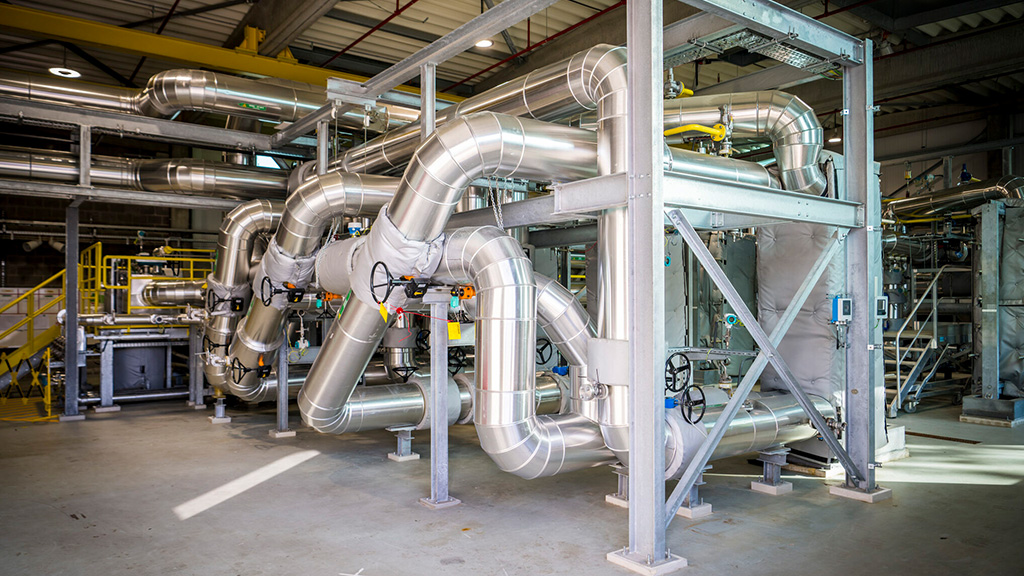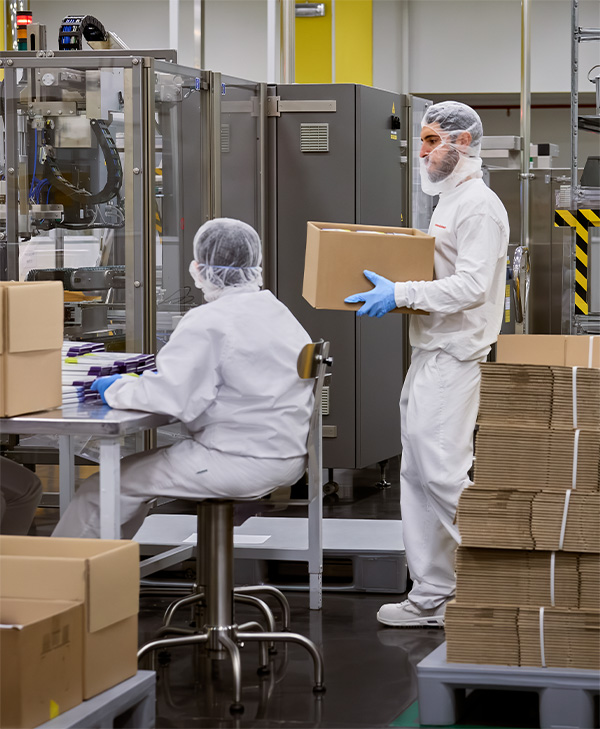To support a healthy environment, we focus our efforts on four key areas: decarbonizing our operations and value chain, delivering more sustainable products and solutions, advancing environmental health equity and empowering our employees to lead the way on sustainability. Policies & Positions: Position on Climate Action
Decarbonizing our operations and value chain
In 2023, we submitted new climate goals to the Science Based Targets initiative (SBTi) to reflect J&J’s new environmental footprint following the creation of Kenvue as a separate company. These goals, which were validated by SBTi as being aligned with climate science, build on our past efforts to reach 100% renewable electricity and reduce GHG emissions in our global operations while also engaging key suppliers on their own decarbonization efforts. We continue to make progress in all of these areas.
Since 2021, our absolute Scope 1 & Scope 2 GHG emissions have reduced 23% (absolute reduction), from 574,165 MT CO2e in 2021 to 442,880 MT CO2e in 2023.

Johnson & Johnson received an A- score in 2023 for leadership in environmental transparency and climate change performance.
Increasing use of renewable electricity
We are making meaningful progress in sourcing renewable electricity across our operations around the world, with 87% of our global electricity sourced from renewables. We currently maintain 44 on-site renewable energy systems in 20 countries, and we have executed 14 contracts for off-site renewable electricity procurement. Our use of renewable electricity is a significant factor in reducing our operational emissions.
Renewable electricity across our operations (as of the end of 2023)33
Global
U.S. and Canada
Europe
Renewable Electricity
Health for Humanity goals
Our goal
By 2025, source 100% of our electricity needs from renewable sources.
Our results
- 87% of electricity is produced or procured from renewable energy sources.
On track
GHG Emissions
Health for Humanity goals
Our goal
Reduce absolute Scope 1 & 2 GHG emissions 44% by 2030, from a 2021 base year.
Our results
- 23% (absolute reduction) in Scope 1 & 2 carbon emissions vs. the 2021 baseline.
On track
Value Chain
Health for Humanity goals
Our goal
80% of J&J suppliers by emissions covering Purchased Goods and Services and Upstream Transportation and Distribution will have science-based targets by 2028.
Our results
- In 2023, 28% of our suppliers by emissions covering Purchased Goods and Services and Upstream Transportation and Distribution had approved science-based targets.
On track
Reducing operational GHG emissions
We continue to invest in energy-efficient processes and equipment and decarbonization efforts at our sites. Since 2005, we have allocated up to $40 million per year in capital relief through our CO2 Capital Relief Program for energy projects that demonstrate potential CO2 savings and a financial return. Examples of completed projects in 2023 include a solar project at the Ethicon San Lorenzo, Puerto Rico, manufacturing facility, reducing the site’s GHG emissions. Our geothermal plant in Beerse (see below) also benefited from our CO2 Capital Relief Program.
CO2 Capital Relief Program (2005 – 2023)34
annual energy cost savings
projects completed
annual energy savings
total spent on completed projects
annual GHG emissions avoided
Inaugurating our deep geothermal plant in Belgium
In 2023, we celebrated the inauguration of our deep geothermal energy plant at the J&J Innovative Medicine Campus in Beerse, Belgium. This is a state-of-the-art plant and the first of its kind in Belgium on an industrial and private scale. It is equipped with the latest geothermal technology, which ensures efficient and reliable energy production, reducing J&J Innovative Medicine’s CO2 emissions in Belgium by approximately 30%. In addition to funding from J&J’s CO2 Capital Relief Program, the project received financial support from Flanders (Flemish Energy and Climate Agency and the Flemish Innovation and Entrepreneurship Agency), as well as from the European Regional Development Fund.

On-site generated energy use by type (TJ)
Environmental certifications at our sites in 2023

J&J colleagues in the packaging unit at our Latina, Italy, site which distributes medicines around the world
Addressing upstream emissions
We remain committed to reducing carbon emissions across our extended value chain, and we have implemented several workstreams to help mitigate our Scope 3 emissions. These workstreams include our work to address cutting emissions in our supply chain, logistics and clinical trials.
Engaging suppliers in climate action
This includes engaging our key suppliers in climate action across our global supply base, which is critical to reducing our Scope 3 GHG emissions. We continued to make advancements on our upstream Scope 3 strategy, including:
- Driving reductions: As part of our ongoing work with Manufacture 2030, we collaborate with industry peers to engage API suppliers through the Activate program and also engage external manufacturers to align with science-based decarbonization targets, drive more sustainable procurement and identify opportunities for operational and resource efficiency.
- Improving data quality: We are collecting more detailed sources of emissions data for our supply base, as well as using our data science capabilities to visualize CDP Supply Chain data that show the maturity level of our largest-emitting suppliers, including their goals, emissions footprint and reductions, to support more targeted supplier engagement.
- Building capacity: Through our Onward Program, we help educate suppliers on the business reasons for setting science-based climate goals. Through the Energize program, we are collaborating with peer companies to provide training and resources to support renewable energy adoption for pharmaceutical suppliers. Through the Pharmaceutical Supply Chain Initiative (PSCI), our suppliers have access to climate-related training (see sections: Responsible supply base, Engaging employees for a healthy planet).
Reducing logistics emissions
We continue to identify opportunities to reduce emissions from our transportation and logistics operations. This includes transitioning some of our product shipments to lower-emitting modes of travel. For example, in 2023, J&J MedTech implemented a pilot for shipments from a distribution center in Belgium to China by rail instead of air to reduce emissions from air travel.
Cutting emissions in clinical trials
In 2023, we completed lifecycle analyses on eight clinical trials spanning different therapeutic areas, allowing us to identify key activities that drive the majority of carbon emissions in our trials. This information could help us design lower-carbon clinical trials in the future by introducing targeted actions, such as minimizing drug waste in clinical trials, reducing the footprint of central lab sample logistics, and decreasing the travel of both research participants and operational staff.
We continued to participate in coalitions to accelerate our own progress, as well as the overall decarbonization of healthcare, including:
- Clean Energy Buyers Association
- The National Academy of Medicine’s Action Collaborative on Decarbonizing the U.S. Health Sector
- The Sustainable Healthcare Coalition (UK)
- WWF Climate Business Network
We also engage to address the impacts of health inequities exacerbated by climate change (see section: Addressing the impacts of climate change on health equity).
Additionally, for decades, we have maintained a robust environmental management system and mature programs to reduce the environmental footprint of our sites and to manage our work across multiple environmental impact areas, including water stewardship, waste management and biodiversity. Policies & Positions: Position on Environmental Stewardship
33 This data is the percentage of electricity used by Johnson & Johnson that is generated from renewable sources, including on-site and off-site renewable systems, like direct PPAs, virtual PPAs, Utility Green Tariffs and Energy Attribute Certificates. Europe includes Belgium, France, Germany, Greece, Ireland, Italy, the Netherlands, Poland, Spain, Sweden, Switzerland and the UK. North America includes the U.S. and Canada only. U.S. does not include Puerto Rico.
34 Data in this table refer to J&J Innovative Medicine and MedTech only. Data relating to the former Consumer Health segment are not included.
35 Includes Building Research Establishment Environmental Assessment Methodology (BREEAM).




